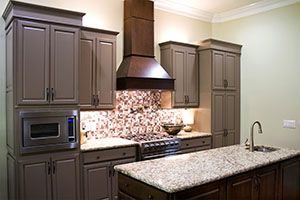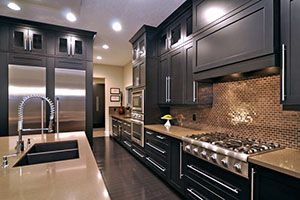Selecting the right finish for your kitchen cabinets is crucial for defining the style and durability of your kitchen. This guide explores the various finishes available for kitchen cabinets, providing insights into how each can influence the look, feel, and longevity of your kitchen design. Whether you’re renovating an old kitchen or building a new one, understanding these finishes will help you make informed decisions that align with your aesthetic preferences and practical needs.
Table of Contents
ToggleKitchen Cabinet Finish Materials
Below are the most common finishes you are likely to find on kitchen cabinets.
Paint
One of the most common and versatile materials for kitchen cabinet finishes is paint. Paint is available in a virtually limitless palette of colors, enabling you to choose the best one for your particular kitchen design and color scheme.
Milk Paint
This is technically still paint, but it deserves a separate entry because it is organic-based, as opposed to the enamel base used in standard wood paint. It is a combination of lime, milk protein (hence the name), and natural dyes. Milk paint has been in use for centuries and has a good absorption on wood. It is durable and water-resistant and has an attractive look evoking the texture of period and vintage fixtures.
Stain
Wood stains are surface coloring agents that change the original color of the wood substrate but still allow the grain of the wood to remain visible. They are the decorative component of this treatment. A clear sealer on top of the stain provides protection from the kitchen environment.
Varnish

You may also have the option to apply a catalyzed varnish, also known as a conversion varnish, which is basically a high-tech version of the standard varnish. This type of surface treatment involves the application of a catalyst such as urethane to make the varnish dry faster and with more durability. Cabinets treated with catalyzed or conversion varnish will last much longer, all things being equal, than cabinets treated with other finishes.
Lacquer

Glaze

Process
The appropriate type of finishing process will depend on the capacity of the cabinet manufacturer and the type of preferred finish. Bigger cabinet manufacturers may have the machines, facilities, and workforce to carry out sophisticated finishing techniques, while smaller outfits may use simpler processes or outsource the finishing to specialty firms.
In general, finishing a wood cabinet involves several steps, from preparing the surface to baking in the finish. Schrock, for example, has a 12-step process:
1. Selecting the best wood panels
2. Sanding it down smooth
3. Applying a toner
4. Applying a stain
5. Hand wiping off the excess
6. Applying the catalyzed sealer
7. Oven curing and drying
8. Hand sanding
9. Removing dust
10. Applying the catalyzed topcoat
11. Oven curing
12. Final inspection
Large manufacturers are more likely to provide a consistent finish to cabinets because they have the resources to do quality work in a relatively short time. They have facilities that are free of dust and dirt, which is essential for a flawless finish. This is not always the case with smaller outfits, at least not with the same capacity. You can still get quality finishes from these smaller companies, but they may take longer or cost a bit more.
In general, finishes that require hand treatments or more steps require higher labor costs, which translate to higher overall costs for the final product. This applies to both large and small manufacturers. Applying a glaze, for example, adds a pleasing dimension to the cabinet surface. However, this step may unnecessarily add to your cost. You may be able to cut costs by choosing just the essential finishes you need for your kitchen design.
Conclusion
Choosing the right finish for your kitchen cabinets is essential for achieving the desired aesthetic and ensuring long-term durability. From classic paint to organic-based milk paint, each material offers unique benefits and affects your kitchen’s overall look and feel. More complex options like varnishes, lacquers, and glazes offer additional protection and aesthetic enhancements but may vary in cost and application processes.
Understanding these finishes and their application processes helps ensure that you select a style that meets your visual preferences and stands the test of time in functionality and style. Whether opting for a simple stain or a more durable catalyzed varnish, the right finish can significantly impact the quality and enjoyment of your kitchen space.






